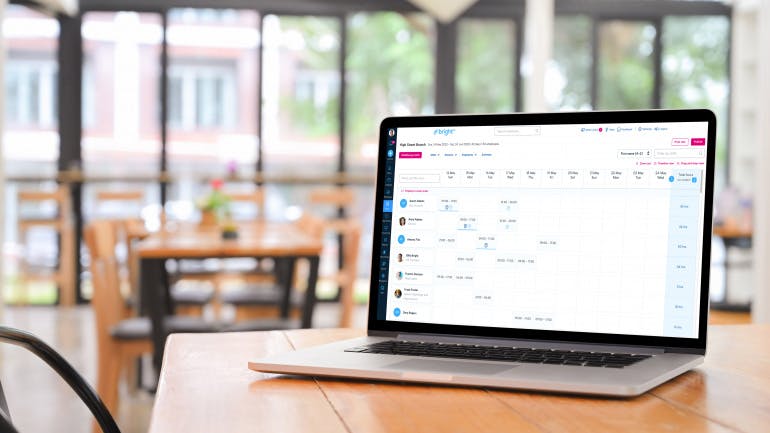First published on Thursday, June 25, 2020
Last updated on Wednesday, November 13, 2024
Let’s be real—creating a rota is often one of the trickiest parts of managing a business. Balancing peak hours, employee availability and making sure you’re not over or understaffed is no easy task.
But, with a bit of planning, the right strategies, and maybe a little help from staff rota software, you can create efficient rotas that keeps both your operations smooth and your team happy.
Here’s a breakdown of how to get it done, with minimal headaches and maximum efficiency.
Understand your business’s needs first
Before you dive into your team’s availability, start by looking at your business. What does your operation really need?
Figuring this out first will help you avoid either understaffing, which can hurt customer service, or overstaffing, which will eat into your bottom line.
So, here’s what to focus on:
• Identify peak times: When is your business busiest? Is there a Monday morning rush or a Friday night spike? Recognising these trends will help ensure you’ve got enough staff at the right times.
• Align with budget: Always keep labour costs in mind. Sure, having extra hands-on deck can feel like a safety net, but overstaffing can lead to unnecessary expenses.
• Match skills with demand: Do you need more experienced staff during high-traffic periods? Or can you afford to have a mix of new hires and seasoned employees?
Talk to your employees about their availability
Once you’ve mapped out your business needs, it’s time to connect with your team. An efficient rota takes employee availability and preferences into account as much as possible. After all, happy employees are more likely to show up on time and stick around.
Here’s how you can gather their availability:
• Use a clear process: Whether it’s a digital form, software, or a good old spreadsheet, make it easy for employees to share their availability and time-off requests.
• Ask about preferences: Some people thrive in the mornings; others are night owls. If you can accommodate these preferences, you’ll see a big boost in morale (and likely fewer sick days).
• Set boundaries for time-off requests: Create a clear policy for requesting time off and encourage employees to get their requests in early. This way, you can minimise last-minute gaps and confusion.
And don’t forget the importance of maintaining a healthy work-life balance. If you’re piling shifts on your best employees, they may look fine for now, but burnout will sneak up like a shadow in the night, quietly and unexpectedly.
Use technology to streamline the process
Let’s face it—manually creating rotas can be a nightmare, especially when you have a growing team. This is where using the right rota software can be a game-changer. It not only saves you time but also makes the process more transparent for your staff.
Consider these tools:
• Shift and rota platforms like BrightHR: These allow employees to input their availability, accept and decline shifts, and request time off directly. For you, they make the whole process much easier, thanks to drag-and-drop interfaces and automated notifications.
• Mobile access: Some rota software lets employees check their shifts on their phones. This means fewer “I didn’t know I was working” calls or late arrivals.
• Integrate with payroll: Some tools also integrate directly with payroll, making your life a whole lot simpler.
Build flexibility into your rota
No matter how perfect your rota looks, sometimes things come up; someone may get sick, a family emergency may arise, or the unexpected could happen. That’s why it’s important to leave a little breathing room in your rota.
Here’s how to create that flexibility:
• Have on-call staff: If your business can afford it, keep a couple of part-time or on-call employees in the mix for emergencies. They can cover last-minute shifts or step in if someone can’t make it.
• Cross-train your team: The more versatile your employees are, the easier it will be to fill gaps. For example, if your cashier is also trained in inventory or your server can cover for the bartender, you’ve got flexibility built in.
• Allow shift swaps: Letting employees swap shifts (within reason) can reduce the burden on you to constantly juggle changes and keep everyone happy.
Create fair and consistent rotas
Nobody likes feeling like they’re getting the short end of the stick when it comes to shifts. Whether it’s getting stuck with weekend shifts, late nights, or holiday coverage, it’s important to keep things fair.
Here are some tips for keeping your rotations fair:
• Rotate tough shifts: Make sure less desirable shifts (like weekends or late nights) are fairly rotated among your team.
• Balance seniority and fairness: While senior employees might get first pick of shifts as a perk, you don’t want newer employees to feel like they’re stuck with the worst shifts all the time. So, try to strike a balance.
• Set limits: If someone is repeatedly asking for prime shifts or weekends off, you may need to step in and set limits to ensure the rota is fair for everyone.
Communicate early and clearly
One of the biggest mistakes when creating a rota is failing to communicate with your team in advance. You know how frustrating it is when someone springs a change on you without notice? Your employees feel the same. So, make sure you’re giving them their rotas with plenty of lead time.
Here’s how to do it:
• Release rotas early: Aim to release your rota at least two weeks in advance. This gives employees time to raise any concerns or adjust their plans.
• Notify of changes ASAP: If you need to make any changes, let your team know as soon as possible. Nothing frustrates employees more than last-minute changes.
• Open a feedback loop: Encourage your employees to share feedback on the process. If someone feels overworked or like they’re consistently getting bad shifts, you want to hear about it so you can make adjustments.
Stay on top of UK employment laws
A rota isn’t just about meeting business needs and employee preferences—it’s also about complying with UK employment laws.
In the UK, employment laws regulate work hours, overtime, and breaks, so it’s essential to stay informed about the rules. If you’re ever uncertain, don’t hesitate to consult employment law experts.
Monitor, adjust, and improve
Creating a rota is just the first step. Once it’s in place, you need to keep an eye on how well it’s working. Are you hitting your productivity targets? Are employees consistently calling out on certain shifts? Adjusting the rota over time is key to long-term success.
Here’s how to refine your rota:
• Track attendance and productivity: If certain shifts always seem to have absenteeism or lateness issues, it might be a sign to reconsider who’s working or how the shift is structured.
• Listen to your team: Pay attention to feedback from your employees. Are they feeling overworked? Do they need more downtime between shifts? Making adjustments based on their input can improve morale and performance.
• Tweak as needed: Creating a rota is a dynamic process. Be ready to make changes as your business grows or as you notice patterns in employee behaviour or customer demand.
Discover an award-winning staff rota software
Creating an efficient staff rota doesn’t have to be a headache. By focusing on your business’s needs, listening to your team, using the right tools, and staying flexible, you can build a rota that works for everyone.
Remember, the key is to find the balance between operational efficiency and employee satisfaction.
To make things even easier, discover stress-free shift and rota planning for any working pattern from BrightHR with our online staff rota software.










